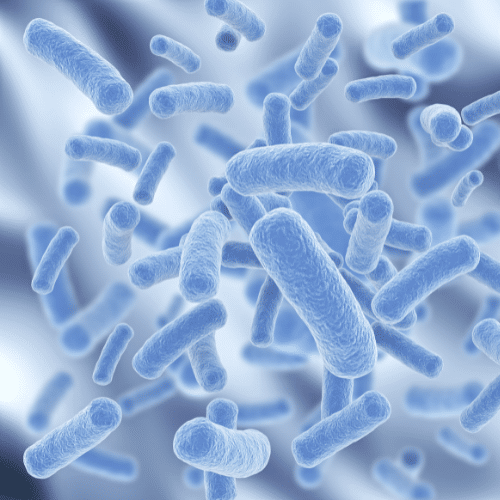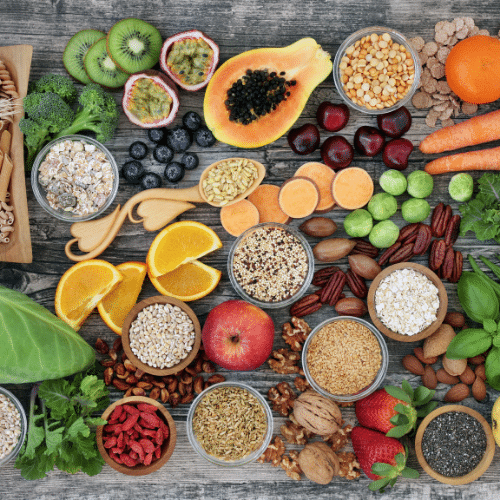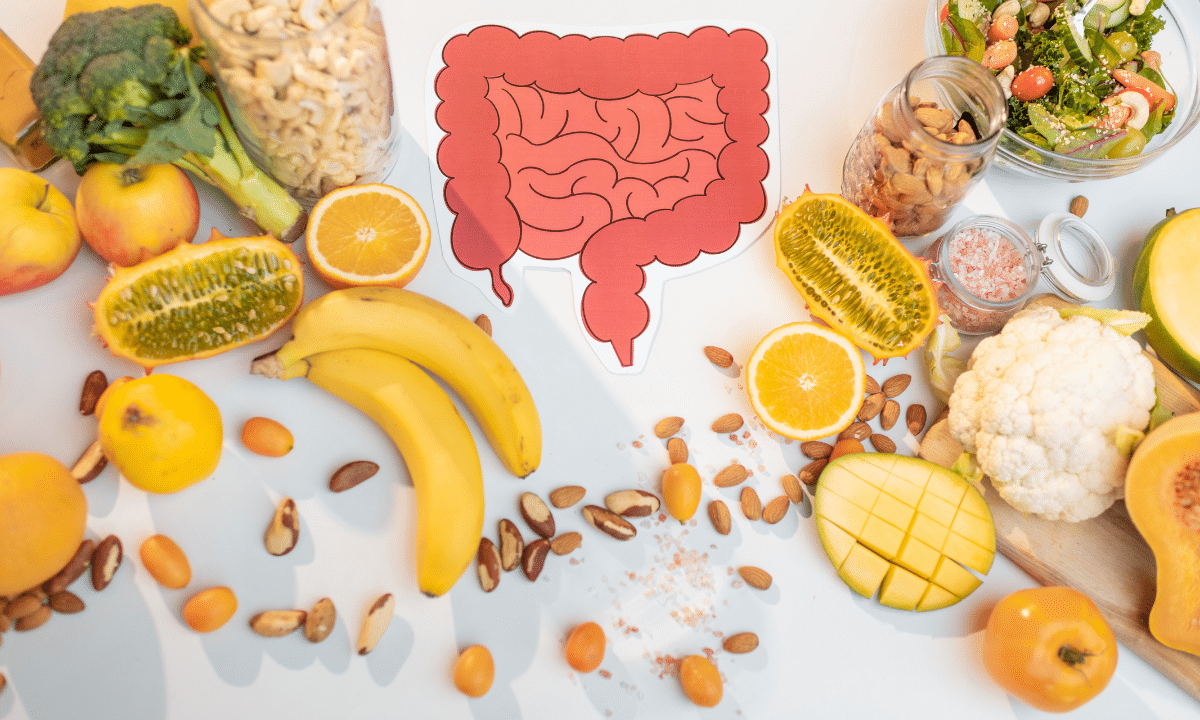Difference Between Prebiotics and Probiotics
Though you may be familiar with the terms “prebiotics” and “probiotics,” you may not know exactly the difference between them. Probiotics are used to introduce good bacteria into your system, while prebiotics are used to feed the good bacteria that are already in your system.
Table of Contents
ToggleBoth prebiotics and probiotics are beneficial for overall health, though they work differently.
What Are Probiotics?
Simply defined, probiotics are good bacteria and yeasts. They live in the large intestine, mouth, vagina, urinary tract, skin, and lungs.
Because probiotics are good bacteria, they can be helpful in balancing between good and bad bacteria.

Maintaining a balanced level of good bacteria can help prevent illnesses, boost your immune system and your overall health.
For example, when you get an infection, you have more bad bacteria in the body than good bacteria. In that case, adding good bacteria help get rid of the bad bacteria and return our body to balance.
While your microbiome is as unique as a fingerprint, we all share common species of bacteria.They belong to groups lactobacillus and bifidobacterium.
Other common microorganisms include yeasts such as Saccharomyces boulardii.
What Are Prebiotics?

Prebiotics are a form of dietary fiber that feeds good bacteria in our large intestines. They can be found in complex carbohydrates in fruits, vegetables, legumes, and whole grains.
These fibers pass undigested through the stomach unchanged, nourishing the good bacteria in your large intestine.
Prebiotics help the probiotics to thrive and work more effectively by providing them with energy, which makes it easier for probiotics to colonize and multiply in your digestive system. This helps promote healthy digestion and a strong immune system.
Prebiotics can also help reduce inflammation.
What Are the Difference Between Probiotics and Prebiotics?
Probiotics are the good bacteria that we need, while prebiotics can help create the perfect environment for these bacteria to thrive. Prebiotics are plant fibers.
What Are the Benefits?
Probiotics
Probiotics have a large number of potential health benefits:
- Help your body digest food.
- Protect you from harmful bacteria and fungi
- Strengthens your immune system
- It supports the gut lining to prevent bad bacteria from entering your blood.
- Breakdown and absorb medications
- Improves symptoms of depression
- Help address metabolic syndrome and obesity
Probiotics may be used in the treatment or prevention of:
- Diarrhea from antibiotics
- Diarrhea from C. difficile infection
- Constipation
- Irritable Bowel Syndrome (IBS)
- Irritable Bowel Disease (IBD)
- Yeast infections
- Urinary Tract Infections
- Gum Diseases
- Lactose Intolerance
- Eczema
- Upper respiratory Infections
- Sepsis
Prebiotics
The main benefit of prebiotics is that they produce short-chain fatty acids (SCFAs). SCFAs are the main nutrition source for good colon bacteria. In addition, these SCFAs can help reduce inflammation.
The benefits of prebiotics include the following:
- Help grow healthy bacteria in our gut
- Communicate with our immune system
- Stimulate the body to produce hormones that regulate hunger and appetite.
- Promote bowel regularity
- Heal gut-barrier integrity
- Promotes overall digestive health
- Helps reduce inflammation
Prebiotics may be used in the treatment or prevention of:
- Diarrhea
- Inflammatory Bowel Disease (IBD)
- Colon Cancer
Probiotics and Prebiotics Food List
Get the PDF version of the probiotic food list here
Probiotics
To increase your intake of probiotic foods, then focus on eating fermented foods with live cultures.
Best sources of probiotic foods:
- Yogurt
- Kefir
- Sauerkraut
- Tempeh
- Natto
- Kimchi
- Miso
- Kombucha
- Pickles
- Traditional buttermilk
- Fermented cheeses: swiss, provolone, gouda, cheddar, edame, gruyere, cottage cheese
- Sourdough bread
Prebiotics
To increase your intake of prebiotic foods, focus on eating 25-35 grams of fiber per day. As you already know, fiber is in vegetables, fruits, whole grains, nuts, seeds, and legumes.
Get the PDF version of the prebiotic food list here.
To eat the best sources of prebiotic foods, include foods from the following list.
Best sources of prebiotic foods:
- Chicory root
- Dandelion greens
- Jerusalem artichoke
- Garlic
- Onions
- Leeks
- Asparagus
- Bananas (green, unripe)
- Barley
- Oats
- Apples
- Potatoes (cooked and cooled)
- Cocoa
- Konjac Root
- Burdock Root
- Flaxseeds
- Yacon Root
- Jicama Root
- Wheat Bran
- Seaweed
Should I Take a Supplement?
Supporting your gut health is always a good idea. Of course, the best way is by eating foods high in probiotics. However, sometimes is difficult to get all the support you need with food alone.
So, for many taking a supplement is a good idea. It can be especially helpful when some specific issue arises or when you’re on a course of antibiotics. Then, it’s important to look for the right supplement with many options in the market.
At the end of the day, it is a personal decision based on your health requirements and lifestyle. A Registered Dietitian and your doctor can help you choose the right supplement for you.
Risks of Taking Supplements
The primary risk of taking probiotics and prebiotic supplements is that supplements are not regulated by FDA. So, it is important to buy probiotics and prebiotic supplements from a reputable source.
Also, your microbiome is so sophisticated that supplements might or might not be beneficial for you.
How to Choose a Probiotic Supplement?
When choosing a supplement, consider the following aspects:
- Choose probiotic products with at least 1 billion colony-forming units (CFUs)
- Select probiotics containing Lactobacillus, Bifidobacterium or Saccharomyces boulardii because these ar
How to Choose a Prebiotic Supplement
Below are tips on choosing a prebiotic supplement:
- Start with 3g and work your way up to 5g of prebiotic fiber.
- Start with a small serving size of prebiotic fiber and gradually increase your dose to avoid mild gastrointestinal symptoms.
- Look for ingredients like acacia, psyllium husk, partially hydrolyzed guar gum, chicory root, inulin, fructooligosaccharides (FOS), oligofructose, or galactooligosaccharides (GOS).
- Individuals with Irritable Bowel Syndrome (IBS) may do better on low-FODMAP prebiotic supplements like psyllium husk, acacia, or guar gum.
- Individuals with Irritable Bowel Syndrome (IBS) should avoid high-FODMAP prebiotics like inulin, FOS, and chicory root.
Tips to Add Prebiotics and Probiotics to Your Diet
Adding more prebiotic and probiotic foods into your diet is as easy as a few simple additions or swaps:
Breakfast
- Smoothie with yogurt, banana, flaxseed
- Oatmeal with chopped bananas and cocoa
- Swapping regular bread for sourdough bread
- Cottage cheese
- Smoothie for gut health
Lunch
- Salad with dandelion greens
- Barley and a spoonful of sauerkraut
- Cooled potato salad
Snack
- Kombucha
- Cheddar cheese on wheat bran crackers with apples
- Jicama sticks
- Pickles
Dinner
- Garlic and onion as flavor enhancers
- Tempeh miso stir fry
- Roasted asparagus or Jerusalem artichokes
- Kimchi
Prebiotics and Probiotics in Menopause
During menopause, the decline in hormones estrogen and progesterone can cause women to experience digestive problems and weight gain. Improving gut health with probiotics and prebiotics can help with both issues.
The Bottom line
Probiotics are the good bacteria that we need, while prebiotics can help create the perfect environment for these bacteria to thrive.
Both are a great addition to improving gut, immune, and metabolic health.
“The Difference Between Prebiotics and Probiotics” was written by Registered Dietitian Rebeca Davis. Reviewed/edited by Su-Nui Escobar, DCN, RDN, FAND.

Dr. Su-Nui Escobar, a Registered Dietitian/Nutritionist in Miami, FL, is dedicated to empowering women in perimenopause and menopause to live healthier, more satisfying lives.
With a doctorate in clinical nutrition from the University of North Florida, she has expertise in menopause and weight loss, including the unique challenges faced by those on weight loss medications.
Su-Nui’s passion for her field is evident in her previous role as the Academy of Nutrition and Dietetics spokesperson.


